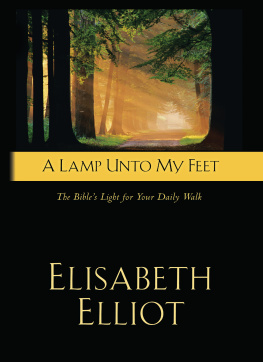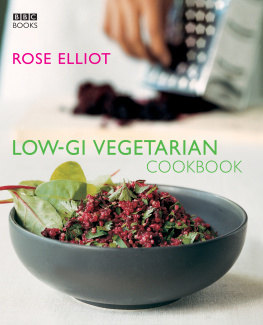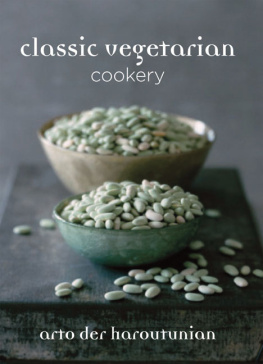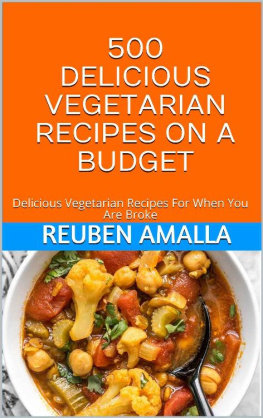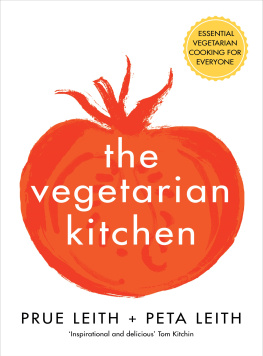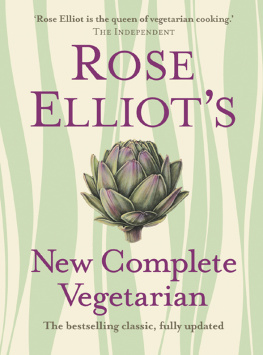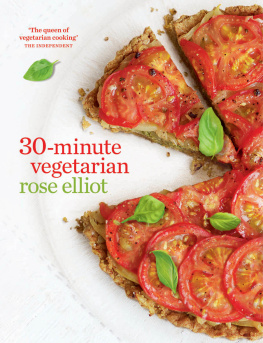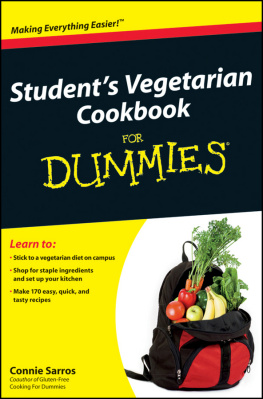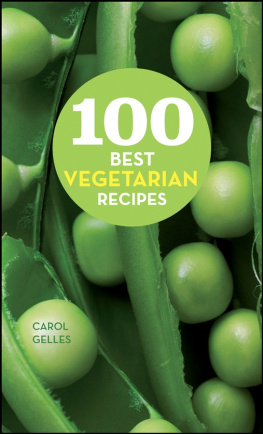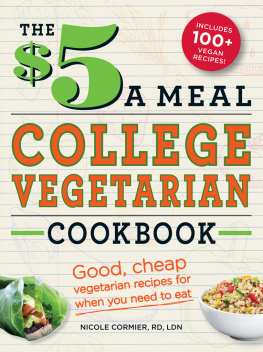
To my daughters,
Kate, Meg and Claire
with all my love
CHEAP FOOD, GOOD FOOD
Theres something very satisfying about producing a tasty, nourishing meal at a rock-bottom price and not having to spend hours in the kitchen in order to do it. Cheap food can undoubtedly be good food, tasty, healthy and quick to make.
There are in the world a wealth of colourful and delicious dishes which have sustained our forebears for generations and still do so today. These use basic, cheap foods which do not need elaborate refining or packaging. They are additive-free, full of fibre and packed with nutrients and they taste great.
Along with these basic international recipes are favourites from an exciting and rapidly developing culinary art, vegetarian cookery. These, too, use the basic, unprocessed foods and bring further variety and interest to money-saving meals.
Including some of these dishes in your weekly menus can save you money; basing your weeks menus entirely on them can cut your expenses by at least a third.
FEELING GOOD, LOOKING GREAT
Contrary to what people think, cheap meals can actually be better for you in terms of health and nutrition than richer, more expensive, meals. Its well known that during the last war, people in Britain were healthier on the meagre diet which rationing enforced. This is because such a diet relies on basic foods such as potatoes, pasta, wholewheat or wholemeal bread, grains and pulses (legumes). All these contain fibre, are rich in nutrients and free from additives. If you base your meals on these staples, include small quantities of eggs and dairy produce, have a good source of vitamin C each day and, if possible, a good serving of green vegetables, you will be well-nourished, look fit and feel good. Good sources of vitamin C are kiwi fruit, oranges or grapefruit, or some orange or grapefruit juice, a good salad, or a good serving of potatoes, a large piece of melon or a bowl of strawberries.
If youre overweight, youll probably find that you shed the extra weight naturally, as long as you keep away from the desserts and puddings, pies and cakes, which provide extra fillers for families and very active people. Replace ordinary milk with skimmed (non-fat) milk and use reduced-fat cheese for useful savings in calories.
SAVING TIME, SAVING MONEY
Its possible to save a great deal of time and money by following a few simple guidelines.
Use food in season
Buying fresh food in season makes good economic sense as well as ensuring that you get the best quality. If you grow your own produce and can freeze some of it, that saves even more money. Making use of some of the free wild food to be found, such as chestnuts, blackberries, bilberries and sea spinach and mushrooms with expert identification can be an extra occasional bonus, though probably not enough to make much difference to the weekly budget.
When you grow your own food or pick wild produce you know exactly where its come from and you can avoid chemical fertilizers, pesticides and other chemicals. If growing or picking your own is out of the question, you might consider joining one of the increasingly popular box schemes which provide organically grown fruit and vegetables in season. Organic produce is nearly always a bit more expensive than non-organic, but I do think its money well spent if your budget allows.
Buying organic also ensures that the food is pure and natural and free from G MOs. Even if you cant afford to go all the way with organic food, the Soil Association advises that we should try to buy organic carrots, lettuces, strawberries, bananas, milk, chocolate and soya products, because these are the ones treated with the most chemicals or, in the case of soya, most likely to contain GMOs. Unfortunately there are soya products in 60 percent of supermarket goods, so in order to avoid GMOs its best to buy from one of the supermarkets which has guaranteed their produce to be free from them, if you cant buy organic. When buying organic, look for the Soil Association logo to be really sure of the quality.
Make full use of vegetables
Vegetables represent excellent value for money: theyre full of nourishment, and, being high in fibre, theyre filling and health-giving. Make them the basis of meals often there are plenty of main-meal vegetable recipes in this book. Always try to serve a vegetable or salad alongside a main course, for extra interest and to make the more expensive ingredients go further.
Use the basic proteins
These are the grains, lentils, beans and pasta which have sustained generations the world over. Again, these are excellent value, both in terms of health and money. Add just small quantities of more concentrated proteins such as eggs, cheese and nuts to turn them into tasty and highly nutritious meals.
Plan ahead
This does not necessarily mean you have to plan out meals for a whole week, but it helps to think in terms of two or three days at a time, because it doesnt take any time to cook an extra amount of rice or lentils, and very little time to fry an extra onion, prepare a double quantity of potatoes, breadcrumbs or grated cheese or make some extra mashed potatoes, and these can really save time and effort in the future.
Here are some example of menus which think ahead; you dont have to serve the second meal on the following day as leftovers will keep for at least a day, if not two or three, covered and refrigerated.
to serve with crusty bread another day.
If youre serving delicious .
When youre making mashed potatoes to serve with a meal, make a double quantity ready for topping a , or perhaps a Greek salad, for added interest.
If youre making pastry, perhaps for a , which are a healthy treat for children when made with wholewheat pastry and a reduced sugar jam.
A basic semolina mix, can be used to make , both of which are perennial favourites. The cheese fritters are good served with parsley sauce, chips or new potatoes and a freshly cooked vegetable; the gnocchi are nice with a tomato and onion salad.
Some recipes which you like and never get tired of are worth making in a double amount, so that you can have two servings of them in the week. , which Ive already mentioned, is a dish which I, personally, never get tired of. Make a double batch of this and you can serve it once hot with brown rice, then you can have the rest cold, as a salad, on another day, or you can use it to fill a baked quiche case or crepes. You can also put the ratatouille in a shallow ovenproof dish, make some hollows in it and break an egg into each hollow, then bake in a moderate oven until the eggs are just set, and serve with crusty bread.
Its always useful to make more breadcrumbs than you need, especially if youve got a food processor to make them in and a freezer in which to store them. I keep breadcrumbs in a plastic bag in the freezer, ready for instant use, and whizz up leftover slices of bread and the ends of loaves to add to them. Then theyre ready for dishes such as .
Some dishes such as very quickly the next day.
In fact, half an hour spent with this recipe book and a notepad and pencil working out some inter-related meals like this, which appeal to you, and making a shopping list, could save you several hours of time during the week.
One more time-saver and flavour-enhancer: Ive found chopped fresh parsley to be invaluable in adding flavour to dishes made from cheap ingredients. It really is worth the expense or, better still, worth the effort of growing some lots in fact. Then wash and chop it by the handful so that you have a plastic bag of it in the freezer, ready for instant use.
Next page

